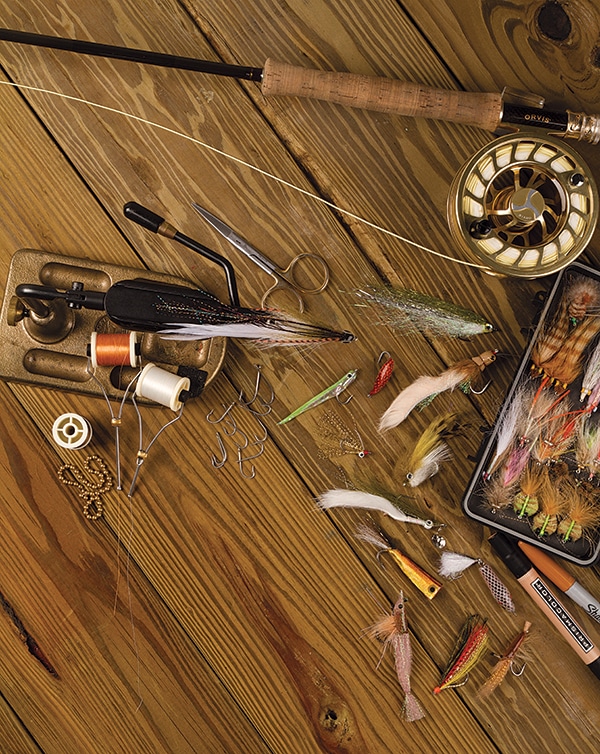
Saltwater fly-fishing anglers for decades have debated the question of when a fly is no longer a fly. I called Fly Fishing in Salt Waters‘ editor at large Lefty Kreh and asked him what he remembers about this topic. Lefty said, “In 1965, Mark Sosin, Charley Waterman, Stan Gibbs, Joe Brooks and I were on the advisory committee for the Saltwater Fly Rodders of America. We were asked to help formulate the rules for establishing world record fly-caught fish. We came up with a standard that basically stated that a fly is anything that can be repeatedly cast without strain on both the anglers and their equipment.” At that time, Lefty told me, the use of lead on a fly was considered out of bounds and unacceptable. Yet his dear friend Joe Brooks’ favorite bonefish fly of that time was a small crappy jig that for all purposes was deemed illegal.
How has this creed of traditionalism affected what we consider a fly versus what is not? Take a look at what flies are made available to anglers today in catalogs sent to us by the likes of Umpqua, Rainy’s and others. There are multitudes of flies that incorporate lead, weighted heads, rattles, spinner blades, propellers, lips, foam, epoxy, soft plastic and a plethora of other materials that many anglers deem as not being flylike. Where do we draw the line to say that this is a fly or that is a lure?
Back in the ’80s, Bob Clouser designed what saltwater anglers today consider the most effective fly pattern ever: the Clouser Deep Minnow. Incorporating lead eyes in this revolutionary pattern allowed anglers to have a lifelike fly pattern that sank into the feeding zone more quickly and caught fish in just about any situation. Some anglers embraced this innovative design while others said it was a fly-fisherman’s version of a bucktail jig and was simply not a fly. One of the more outspoken traditionalists was Kenny Abrames, author of Striper Moon and A Perfect Fish: Illusions in Fly Tying. Abrames has a vast following of dedicated saltwater fly-anglers. His philosophy of using more-traditional tactics carried a lot of weight in the striped bass community. Are his opinions correct?
Fly tier extraordinaire Blane Chocklett designed the Gummy Minnow fly back in 2001. The Gummy Minnow has taken as many, if not more, world record fish in salt waters as any other fly. The fly is tied out of Sili Skin, which for all intents is nothing more than a soft plastic material. Many traditionalists scoff at this pattern, saying that it is not tied or dressed but rather assembled. Could the likes of this fly have Izaak Walton spinning in his grave? Do we dare say that it is not a fly but rather just another version of a fly-fisherman’s Zoom Fluke or Sluggo bait (both soft plastic lures)?
Certainly, I am not going to be the one to cast the first stone in this magazine. Back in the early ’90s I designed a fly called the Coyote to replicate a Blakemore Road Runner lure. I had caught thousands of striped bass on a Road Runner long before I ever picked up a fly rod. The Coyote incorporates a spinner blade on the front section of the fly, which helps attract fish and elicit more strikes. I was living in Stamford, Connecticut, when I first came out with the fly. Some anglers thought it was an excellent fish-attracting fly pattern while others said simply, “Nice lure, Henry.” I myself was determined to figure out whether this was truly a fly or not. I called upon one of my local fishing heroes (Lou Tabory), who happened to live in Connecticut, for his advice. Tabory said, “In my opinion, if it can be cast on a fly rod but not on a spinning rod then it is a fly. However, why don’t you send it to the folks at the International Game Fish Association and see what they have to say about it?” Thinking this was great advice, I immediately got on the phone with the IGFA and spoke with then acting director Mike Leech, who asked me to send five flies down for review by the association’s acting fly-fishing committee, made up of Billy Pate, Mark Sosin, Stu Apte, Lefty Kreh and Chico Fernandez. Five Coyotes were tied and sent to IGFA headquarters in Florida. Within a short time, a letter came back stating that, if a fish were to have been caught, landed and sent in for verification of a pending line-class world record on a Coyote, it would have been recognized as fly-caught.
Today, the debate still continues. So is tradition standing in the way of progress? Both Lefty Kreh and Bob Clouser say that too many times tradition has helped impede development of new fly patterns. In doing so, they say, this is simply bad business for the sport of saltwater fly-fishing. It leads toward elitism, and this sport gets tagged as elitist too often. When I crossed over to the fly-rod side of saltwater fishing, seeing flies designed to emulate lures was natural. It just made sense.
So is Charlie Bisharat’s Pole Dancer fly, which incorporates a large foam head along with a worm rattle and whose movement emulates that of a Zara Spook lure, less of a fly than Lefty’s Deceiver? I guess with this writer’s New York liberal upbringing, I have a view of the world that tells me to keep an open mind and yet stay within the traditions of the sport. I believe if this debate is to continue, it is best left on our trout streams. One thing is for certain: If I am in an all-out albie blitz off of Montauk, I will be the first one to say “Pass me the box with the epoxy surf candies!”









